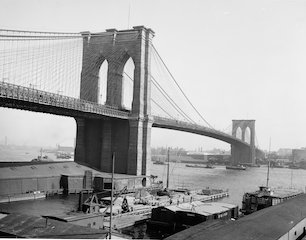Leadership: The Work Below the Waterline Matters
This is an excerpt of my new book: Inside Job: Doing the Work Within the Work. I'd value and appreciate your feedback as this book comes together in upcoming weeks and months. Please leave your comments here or email me at Steve@pottersinn.com. No copies can be made and this should not be used or distributed in print form. Thank you for your attention.
New York City stands host to the infamous and spiraling Brooklyn Bridge. This famous architectural wonder was initially designed in 1857 and completed nearly thirty years later in 1883.
John Roebling and his son, Washington designed and oversaw the construction of the magnificent bridge in which over 20 men lost their lives during the construction period. A bridge of magnitude included loft stone towers, steel cables making it a suspension bridge and have the ability for both trains and traffic to cross back and forth over the infamous East River.
The work began and nothing was visible for years. All the work that was done was work below the waterline. While the bridge was being built, citizens of America’s greatest city could see no action; no progress, no development for several years. The bridge along with it’s designer became the butt end of jokes. What people did not see was all necessary and crucial work. The work below the waterline would be the foundation for all else that was soon to come. But it was work that happened way down deep on the river’s floor.
The bridge’s importance could not be overstated. The Brooklyn Bridge would connect major parts of the city which were cut off from each other by the East River. Many factors had to be considered. The East River was New York City’s major shipping lane. The bridge’s suspension cables would have to be high enough to allow large ships to pass underneath. There was also fierce turbulents in the water as it’s flow was governed by the tides.
To build the two massive towers, John Roebling designed colossal caissons—enormous wooden boxes with no bottoms to be built on the river’s bottom. These giagantic but unseen structures were essential to form a framework for the concrete and stone towers to be anchored. Compressed air was then pumped into the caissons allowing men to dig at the mud and rock to sink far down into the river’s shifting sands to secure the entire bridge.
This was the work within the work. This unseen yet necessary work was required in order for the enormous Brooklyn Bridge to be erected. Unnoticed and unseen the necessary work of building the foundation was key. What skeptics could never envision, became a reality and the Brooklyn Bridge opened for traffic on May 24, 1883. It cost the designer his life and was delivered over budget but it stands glorious, still strong and absolutely necessary to the traffic patterns of New York today.
John Roebling died in 1869, years before the completion of the Bridge as a result of an accident during it’s construction. His son, Washington Roebling was tapped to stand in his father’s stead to finish the construction. Washington had proven himself in leadership during the Civil War and was highly esteemed.
There are lessons in leadership development for us to consider in the story of the Brooklyn Bridge. The necessary work in leadership development is often unseen and unnoticed. The lesson a leader learns about character, integrity and honesty are truly issues that are below the water line. We don’t “see” someone’s character on paper or even by looking at them in their finest dress. Our inner markers of success are inner. We do not wear them on badges. We don’t write “Joe Brown is a person of integrity” on our name tags. Yet, what is inner and unseen—that which is below the water line of our life foundations is critical.
Without the foundational work—the erecting of the massive and underwater caissons, the bridge would never endure massive weight, the changing of tides and storms. It would topple over in stress if not designed and built properly. The foundation for a leader’s work and life cannot be overstated. It is essential and there are no short cuts to the development of a leader.
The stuff below the water line needing our Inside Job and an understanding that these issue really are the work within the work center around Peter’s list of virtues—these inside markers that define us and make us. These are the building blocks that provide structure for growth—a skeleton to give stature, prominence and security. Without the work that goes unseen, we set ourselves up only to be attracted, if not addicted to the outer markers that allure us and entangle us.
I've noticed in working with thousands of market place and ministry leaders, the work below the waterline seems to be offered as a short-cut. It seems to be offered after the fact of a leader falling in disgrace or in scandal. But what if we did this kind of work before and during our work. Pastors are eager to study theology but most seminaries do not offer courses in ethics, leadership development and soul formation. Pride and ego take over when success is tasted in the marketplace and ministry and the insatiable appetite for more and bigger begins. Business leaders who dismiss ethics and being a person of integrity are jailed and disgraced. But what if the inside job could begin sooner in our lives? What if the work within the work took on importance rather than our salary figure. What if we built a solid foundation before we lead and lead well?
